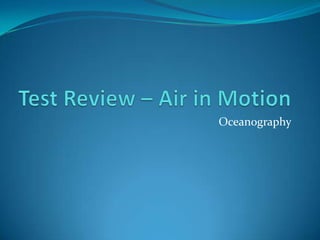
Test Review – Air in Motion (Meteorology)
- 1. Oceanography
- 2. 1. Define water vapor. A cloud droplet.
- 3. 2. Most abundant gases in today’s atmosphere? (%) Nitrogen (78 %) Oxygen (21 %)
- 4. 3. Most abundant gas in the stratosphere? Ozone
- 5. 4. Why does the temperature in the stratosphere increase? Absorbtion of ultraviolet radiation by ozone.
- 6. 5. Formal name of a “stormy and puffy” cloud? Cumulonimbus.
- 7. 6. Freezing point of water in Celsius? 0 (zero)
- 8. 7. Define “Latent Heat.” “hidden” heat. Energy released or radiated during a phase change of water without changing the temperature.
- 9. 8. Solar energy reaches the Earth by… radiation
- 10. 9. What part of the electromagnetic spectrum do we “see?” Visible light.
- 11. 10. In general, where is the best place to see the aurora borealis? at the magnetic north pole.
- 12. 11. Instrument to measure “relative humidity?” psychrometer
- 13. 12. Define: Dew Point The temperature to which air must be cooled in order to become saturated.
- 14. 13. Give characteristics of… Cirrostratus Cumulus Altostratus Stratus
- 15. 14. Condensation nuclei? Microscopic dust or ice where water vapor can condense on to form a water droplet.
- 16. 15. What is the standard unit are air pressure? millibars
- 17. 16. Instrument that measures air pressure? barometer
- 18. 17. Describe offshore (seabreeze) winds. Heat rises over land, cool air sinks, convection current causes winds to blow from the sea.
- 19. 18. What is the main reason that causes sea and land breezes? Temperature differences. Heat capacity.
- 20. 19. Describe a mountain breeze (orographic lifting). Warm air rises on the windward side of a mountain. Cool air interacts with warm moist air to form clouds. Dry air sinks on the leeward side.
- 21. 20. If wind is blowing SLOWER than the rotation of Earth, what direction would the wind “appear” to the observer? west
- 22. 21. What latitudinal areas would have low air pressure? Equator (Doldrums) 60 degrees (Polar Easterlies)
- 23. 22. Describe the following air masses: cP, cT, mP, mT. cP – Dry and cool. cT – Dry and warm mP – Moist and cool. mT – Moist and warm.
- 24. 23. Draw a cold front symbol. What color is it?
- 25. 24. Name and describe the 3 stages of the Thunderstorm cycle. Note when updraft and downdrafts occur! Cumulus – updraft, all upward movement. Mature – downdrafts & downdrafts. Severe weather Dissipation – downdrafts. Severe weather is diminished.
- 26. 25. What is “Lightning?” A discharge on electricity from or within a thunderstorm.
- 27. 26. Where is “Tornado Alley?” In the Central Plains of the United States.
- 28. 27. What is need to “fuel” and hurricane? Moisture, preferably over water. Once it hits land, energy is diminished.
- 29. 28. Describe the following: tropical disturbance, tropical depression, tropical storm, and typhoon. Tropical Disturbance – first indication of a hurricane formation. Sustained winds. Unorganized. Tropical Depression– thunderstorms begin to take circular shape. Winds are less than 39 mph. Tropical Storm – Just before a storm becomes a fully developed hurricane. Winds are 39 – 73 mph. Typhoon – Hurricanes in the Western North Pacific.
- 30. 29. What part of a hurricane has the strongest winds (use cardinal direction)? Northern side
- 31. 30. What part of Earth do most hurricanes form? Equator
- 32. 31. Define heat capacity. Which has a higher heat capacity? The oceans or continents? Describes how quickly or slowly a substance retains heat. Oceans has a high heat capacity. It has the ability to retain heat longer.
- 33. 32. Name the formal names of the seasons. Autumnal Equinox Winter Solstice Vernal Equinox Summer Solstice
- 34. 33. How are clouds formed? Warm moist air + Cool moist air + condensation nuclei. 3 ways: a. Warm air rising b. Orographic Lifting c. Fronts
- 35. 34. Compare and contrast the general temperatures in the equator and the poles. Equator = warm (sun hits it directly) Poles = cool (sun hits it indirectly)
- 36. 35. What happens to the temperature as you increase in elevation? It decreases 4 degrees Celsius/1000 meters.
- 37. 36. What is the scale used to measure tornado intensity? Fujita Enhanced Tornado Scale: F0 – F5
- 38. 37. Define wind shear. A sudden change in wind speed & direction with height.
- 39. 38. What is the scale used to measure hurricane intensity? Saffir-Simpson Scale (Categories 1 – 5).
- 40. 39. Define a hurricane. An intense tropical weather system with a well defined circulation and maximum sustained winds of 74 mph (64 knots) or higher. In the western Pacific, hurricanes are called "typhoons.“ In the Indian Ocean, they are called "cyclones."
- 41. 40. What is a storm surge? Storm surge is an abnormal rise of water generated by a storm, over and above the predicted astronomical tide.
